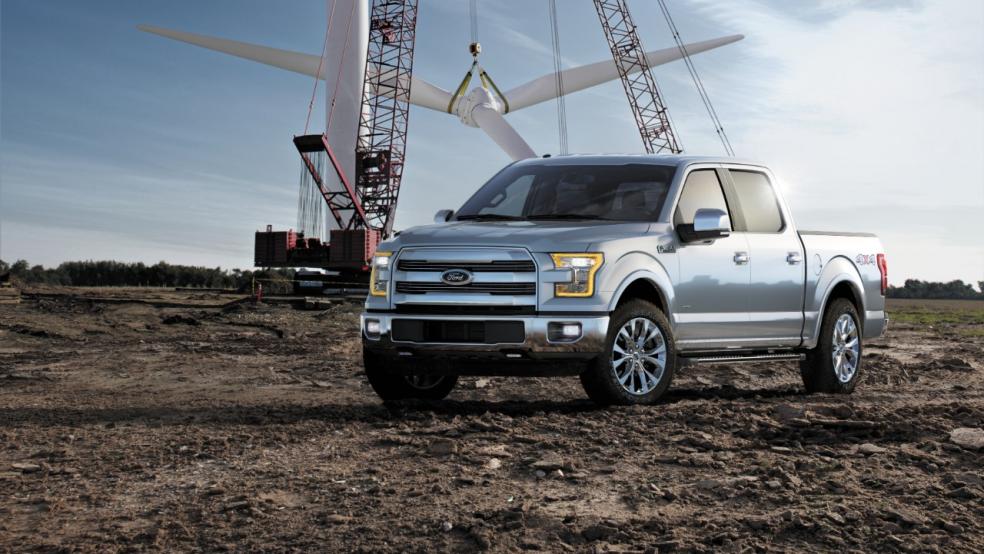The star of the 2014 Detroit Auto Show wasn’t the latest sports coupe or futuristic concept car: It was the latest incarnation of the most mass-market vehicle in North America: the Ford F-150.
The buzz surrounding the truck had nothing to do with its styling or design (which met expectations for a “Ford Tough” look, with some big tech upgrades). Instead, the buzz focused almost entirely on the materials used in constructing the truck. Ford eliminated most of the steel comprising the body of the vehicle, replacing it with lighter weight and more expensive aluminum.
Related: The High-Tech Future of Cars
In doing so, Ford managed to cut the truck’s weight by a massive 700 pounds, making it instantly more fuel efficient as well as enhancing its performance and making it rust-resistant. The aluminum alloys used by Ford are the same that have been used for years in aerospace and energy industries.
“This is a landmark step in truck design,” says Don Sherman, technical director at Car and Driver. “Now, they [Ford] can rightfully claim leadership in a key part of technology in the truck market. No one else is doing this to the extent that Ford is.”
The move reflects a continued effort to meet impending federal rules that require automobile fleets to average 35.5 miles per gallon by 2016 (and 54.5 mpg by 2025), although there are specific fuel-economy requirements pegged to different sized cars. Ford has said that the aluminum F-150 will beat its fuel economy requirements. The F-150 comprises a quarter of Ford’s annual sales, so that would put the automaker leagues ahead of its competitors in terms of meeting the new federal standards.
Related: Detroit Auto Show Greener Cars Are Shedding Pounds
Ford isn’t the first automaker to use aluminum in its vehicles. Luxury car brands like Audi and Jaguar have used it for years, and most new cars these days have an aluminum hood. But its adoption has remained limited because it costs more than steel and its use requires a wholesale makeover of manufacturing plants.
Ford is able to keep the additional costs in check by buying the aluminum in great volume (the F-150 has been the best-selling vehicle in America for more than 30 years), and leveraging economies of scale when it comes to production. If F-150 sales continue on pace, analysts say this change could make Ford the single largest user of aluminum other than the military.
Since trucks typically have far higher profit margins than cars, Ford also has a little bit more wiggle room to increase its costs while continuing to price the F-150 competitively. “Pickups are a price-sensitive market, and Ford is not going to give up the crown of being number one in sales,” says Daniel Hall, a vice president with research and consulting firm AutoPacific. “They’ll price it aggressively to make sure that it still sells well, and they’ll let the story be about the fuel economy.”
Ford has not publicly released its fuel economy target for the aluminum F-150, but analysts expect it to fall in the 30 miles-per-gallon range. Increasing a truck’s efficiency from 25 mpg to 30 mpg could save a driver more than $2,300 after 100,000 miles.
Related: Motor City Is Still Truck City As Sales Jump
“There may be some flexibility and adaptability for increasing prices, because consumers have come to understand that better fuel efficiency is going to cost a little bit more,” says Stephanie Brinley, a senior analyst with IHS Automotive. In addition to the increased efficiency, the new truck boasts some high-tech features worth paying for, including a 360-degree camera, an 8-inch LCD screen in the instrument panel and a lane-keeping system designed to avert unintentional drifting.
Some critics contend that truck-driving consumers will scoff at the idea of driving an aluminum vehicle and wonder if it can really be as “Ford Tough” as a steel truck. Even with its lighter frame, however, the new truck can haul just as much as its predecessor did. The automaker logged more than 10 million miles testing the new truck, which included pulling trailers and heavy loads across both deserts and mountain passes.
F-150 buyers proved surprisingly adaptable a few years ago when Ford introduced the V-6 eco-boost turbo engine in trucks. “The V-6 has become even more successful than the V-8,” says Jessica Caldwell, a senior analyst at Edmunds.com. “I think the truck market is more progressive than people think. And when you’re faced with the prospect of saving money on gas, it’s hard to say no to that.”
This holds particularly true for fleet operators, who make up a good chunk of F-150 buyers, and for whom incremental cost savings can add up. Buyers may also be concerned that repairs to aluminum trucks may be more costly than those on steel vehicles (which could result in higher insurance costs), and auto-body shops may not be equipped to handle such repairs. Ford has said that it’s already tackling those issues.
If the aluminum truck sells as well as Ford hopes, expect to see aluminum making its way into other trucks and cars. “There’s no doubt that GM and others will follow this path to aluminum body construction, in part because once Ford clears the way and solves the manufacturing issues, and any issues with repairs and insurance, it becomes a lot easier for other manufacturers,” Sherman says.
Top Reads from The Fiscal Times:
- The Coolest Green Cars at the 2014 Detroit Auto Show
- The Biggest Challenge for the Big 3 Automakers
- Can Mary Barra Help Make GM the No.1 Global Car Company?





